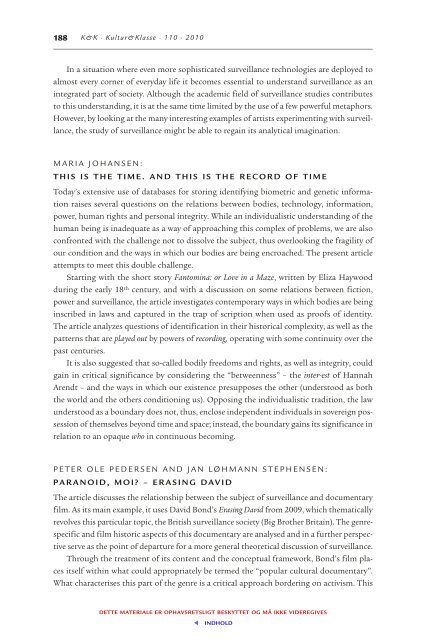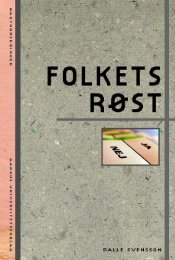K&K. Kultur og Klasse · Nr. 110 · Årgang 2010 - Aarhus University ...
K&K. Kultur og Klasse · Nr. 110 · Årgang 2010 - Aarhus University ...
K&K. Kultur og Klasse · Nr. 110 · Årgang 2010 - Aarhus University ...
You also want an ePaper? Increase the reach of your titles
YUMPU automatically turns print PDFs into web optimized ePapers that Google loves.
188<br />
K&K <strong>·</strong> <strong>Kultur</strong>&<strong>Klasse</strong> <strong>·</strong> <strong>110</strong> <strong>·</strong> <strong>2010</strong><br />
In a situation where even more sophisticated surveillance tech nol<strong>og</strong>ies are deployed to<br />
almost every corner of everyday life it becomes essential to understand surveillance as an<br />
integrated part of society. Although the academic field of surveillance studies contributes<br />
to this understanding, it is at the same time limited by the use of a few powerful metaphors.<br />
However, by looking at the many interesting examples of artists experimenting with surveillance,<br />
the study of surveillance might be able to regain its analytical imagination.<br />
MARIA JOHANSEN:<br />
THIS IS THE TIME. AND THIS IS THE RECORD OF TIME<br />
Today’s extensive use of databases for storing identifying biometric and genetic information<br />
raises several questions on the relations between bodies, tech nol<strong>og</strong>y, information,<br />
power, human rights and personal integrity. While an individualistic understanding of the<br />
human being is inadequate as a way of approaching this complex of problems, we are also<br />
confronted with the challenge not to dissolve the subject, thus overlooking the fragility of<br />
our condition and the ways in which our bodies are being encroached. The present article<br />
attempts to meet this double challenge.<br />
Starting with the short story Fantomina: or Love in a Maze, written by Eliza Haywood<br />
during the early 18th century, and with a discussion on some relations between fiction,<br />
power and surveillance, the article investigates contemporary ways in which bodies are being<br />
inscribed in laws and captured in the trap of scription when used as proofs of identity.<br />
The article analyzes questions of identification in their historical complexity, as well as the<br />
patterns that are played out by powers of recording, operating with some continuity over the<br />
past centuries.<br />
It is also suggested that so-called bodily freedoms and rights, as well as integrity, could<br />
gain in critical significance by considering the “betweenness” – the inter-est of Hannah<br />
Arendt – and the ways in which our existence presupposes the other (understood as both<br />
the world and the others conditioning us). Opposing the individualistic tradition, the law<br />
understood as a boundary does not, thus, enclose independent individuals in sovereign possession<br />
of themselves beyond time and space; instead, the boundary gains its significance in<br />
relation to an opaque who in continuous becoming.<br />
PETER OLE PEDERSEN AND JAN LØHMANN STEPHENSEN:<br />
PARANOID, MOI? – ERASING DAVID<br />
The article discusses the relationship between the subject of surveillance and documentary<br />
film. As its main example, it uses David Bond’s Erasing David from 2009, which thematically<br />
revolves this particular topic, the British surveillance society (Big Brother Britain). The genrespecific<br />
and film historic aspects of this documentary are analysed and in a further perspective<br />
serve as the point of departure for a more general theoretical discussion of surveillance.<br />
Through the treatment of its content and the conceptual framework, Bond’s film places<br />
itself within what could appropriately be termed the “popular cultural documentary”.<br />
What characterises this part of the genre is a critical approach bordering on activism. This<br />
DETTE MATERIALE ER OPHAVSRETSLIGT BESKYTTET OG MÅ IKKE VIDEREGIVES<br />
INDHOLD








